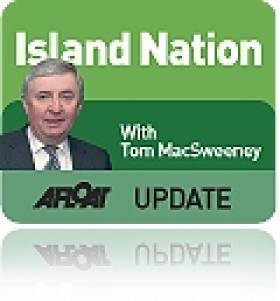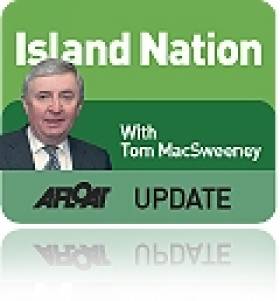Displaying items by tag: sailing
Cullaun Sailing Club Records Biggest Ever Regatta Numbers
#cullaun – Cullaun Sailing Club in East Clare held their Annual September Regatta last weekend which was the busiest they have ever experienced. They had an open regatta with 27 Boats on the water on Saturday and 21 on Sunday. It was a very good sailing and social weekend with Visitors from Killaloe Sailing Club, East Down Yacht Club, Greystones and Ramor Watersports in Cavan. There were perfect wind conditions for the sailors on Saturday and changing to very light conditions on Sunday.
There was no disputing the outright Winner being Monica Schaefer with 4 firsts out of Seven races. She was followed closely by Henry O Freill in second Place followed by Trevor Fisher in third. Margaret Hynes and Michael Hayes were the best Cullaun Club boat over the two days followed by Brian Parks and Chris Caher. They had a mixture of Wayfarers, Enterprises, RS 400, RS200, Lasers and not forgetting one solitary GP14.
Our Juniors Hugh Ward and Paddy Donlon sailed very well on the Saturday but seemed to slow down a little bit on Sunday letting Mike O Dea and Sean Hynes take the lead. They were the best Juniors and excluding Trevor Fisher they were the best in the RS Fleet. The best Improver without any doubt has to go Tommy Scott who's racing skills has improved no end over the last few months.
The number of Junior Sailors that have joined the club and partaken in Easter and Summer Camps have helped raise the profile for CSC with a large number now competing at our Junior and Senior Competitions. It is great to see a lot of the familiar faces travelling large distances to come and compete at our event and we are only delighted to host such events. Cullaun Sailing Club is situated in east Clare approx. 20 minutes from Limerick and Ennis and between the two villages of Kilkishen and Tulla.
For a list of their upcoming events then take a look at www.cullaunsailingclub.com or alternatively like their facebook page at www.facebook.com/Cullaunsailingclub
#sailing – I have been friends for a long number of years with Ireland's two top international sailors who set new speed records for sailing in the Round Britain and Ireland Race. I hear regularly from them and am proud to be in touch with them and, as much as I could, have publicised the progress of their careers over the years I have known them. I believe that giving coverage to successful achievements by Irish sailors at international level is good for the country and for the sport.
Damian Foxall from Kerry and Justin Slattery from Cork deserve to be household names as much as icons in other sports. But, like many sailors, they are not in my view, being given the level of coverage they deserve in the general national electronic and print media.
The progress of the Olympic Providence IRL team at overseas events should also be given more coverage. This week John Twomey from Kinsale YC and his crew have been competing at the world disabled sailing championships in Canada in the hopes of qualifying for his 11th consecutive Games, but this has got little coverage nationally.
Hurling, the Irish women's rugby team, the emergence of potential new stars in Irish athletics, all deserve strong reportage but do Irish sailors not deserve coverage also?
The media at sailing events when there are problems – the GP14 Worlds in Strangford Lough this month; Dun Laoghaire in 2007 are examples of a degree of sensationalised coverage which lacked balance. They were reported as "near disasters," but lacked the qualification that the majority of the sailors looked after themselves, as they are expected in sailing to be able to do. If you go out in a boat, I was told from my first days in sailing, you take the responsibility of getting yourself back in safely.
Sailing deserves better coverage in the national media. Is it being denied that by either ignorance or bias against sailing, or the seemingly ever-present perception of the sport as elitist?
There are sailing journalists who attempt to counterbalance the generally negative attitude towards the sport, but as I found myself when working within RTE, it is an uphill battle and, in an island nation, this is not fair to the sport.
Justin Slattery from Cork is Bowman and a leading member of the Abu Dhabi Ocean Racing's Volvo Ocean 65, Azzam, skippered by Britain's Ian Walker, which crossed the finish line of the 2014 Sevenstar Round Britain and Ireland Race off the Royal Yacht Squadron in Cowes in an elapsed time of 4 days, 13 hours, 10 minutes, 28 seconds. This broke the previous world and race record for a monohull set by Volvo 70 Groupama, in 2010, by 1 day, 8 hours, 16 minutes and 27 seconds.
It was the second world speed record in sailing broken during the Round Britain and Ireland Race organised by the Royal Ocean Racing Club and another Irishman was also involved in the first.
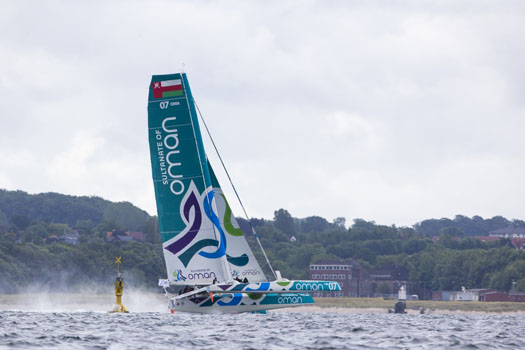
Record breaking Damian Foxall and Oman MOD 70
Ireland's Damian Foxall added the Round Britain and Ireland Speed record time to his impressive offshore sailing CV on board the Oman Sail MOD 70 catamaran. The crew of Musandam-Oman Sail, a MOD70 Trimaran crossed the finish line of the race at with an elapsed time of 3 days, 3 hours, 32 minutes, 36 seconds. This broke the previous world record for a multihull held by Banque Populaire 5 in 2011, by 16 minutes, 38 seconds.
"We hit a new top speed for the boat of 43 knots right at the start," said Damian, Co-skipper on the boat. "The hard thing about a race record, as opposed to a course record, is that with a course record you can wait until the weather is perfect and you just go. In a racing format you don't have that option. The only time we tacked in an 1800-mile circular course was after we had gone through the finish line!""
The MOD70 was skippered by Sidney Gavignet from France, one of the top sailors in the world and who is heading next for the tough Atlantic race, the single-handed Route du Rhum.
It was not all plain sailing for Abu Dhabi's Azzam. Two crew members were hurt during the race. Justin Slattery injured his ribs while trimmer Phil Harmer injured his hand.
And let's not forget the National Yacht Club duo that, despite very heavy weather and suffering major gear failure have persevered in the Round Britain and Ireland Race. The story of their sporting commitment deserves national coverage. Liam Coyne raced two-handed with Brian Flahive on their First 36.7, Lula Belle and they showed a level of spirit and determination that would bring pride to any sport when they won the two handed division.
NEW HELVICK LIFEBOAT
Helvick is a lovely spot on the South-East Coast. A fine little harbour, dominated by fishing boats, with a few dedicated leisure sailors also. I am not too sure about the location of visitor moorings outside the harbour, but at many parts around the coast those could be located in better, more sheltered spots. But that is beside the point of why I am writing about Helvick which is because it has got a new lifeboat through a strong contact with an English family. It is an Atlantic 85, built at a cost of €255,000. It has a number of improvements from the Atlantic 75, Helvick Head's former lifeboat, including a faster top speed of 35 knots; radar; provision for a fourth crew member and more space for survivors. It can operate safely in daylight in up to force 7 conditions and at night up to force 6. It also allows lifeboat crews to respond even faster in emergencies.
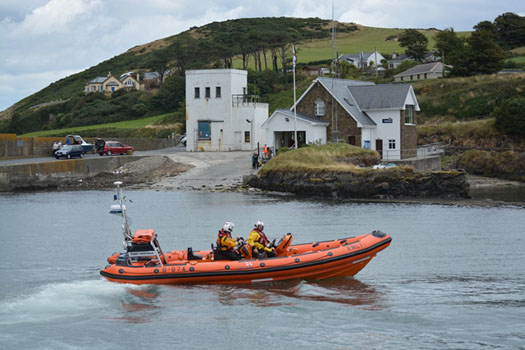
The new RNLB in Helvick and below the late Robert Armstrong after whom the new lifeboat, an Atlantic 85, is being launched in his name at Helvick Head lifeboat station
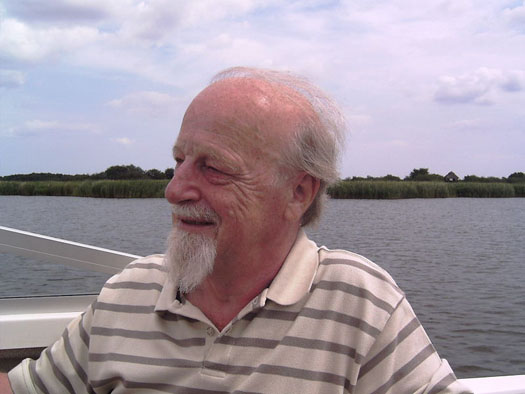
Its name is Robert Armstrong and it was funded by a legacy he left after his death in November of 2009. Born in 1936, he loved sailing, fishing and boats. His home was Blackheath but he had a holiday home in Potter Heigham on the Norfolk Broads, where he moored his own boat. There is a strong connection between the Armstrong family and Helvick. Robert Armstrong's aunt, Alice and her brother Charles, were the donors of Alice and Charles, Helvick Head RNLI's previous lifeboat and Robert had attended the naming ceremony there back in 2000 when he was given an RNLI jacket which he wore proudly.
CROW HEAD'S CABLE CAR
Paul O'Shea has written to me about an event at Crow Head:
"Hi Tom, I would like to promote an event on Crow Head on September 6. Lehanmore Community Coop want to replicate the first ever Cable Car crossing from there to the adjoining island. It will be a joint effort between Kerry Mountain Rescue and Castletownbere Coastguard Unit with the help of Castletownbere RNLI. All funds raised will be donated to KMRT."
HONOUR FOR JOHN TWOMEY
The decision to introduce a "President's Cup" event to honour John Twomey is well-deserved and recognises the achievements of Irish sailors, about which I have written earlier in this week's blog. Sailability Ireland, in conjunction with the ISA, has launched 'The Presidents Cup,' a new championship to encourage sailors with disabilities to compete in the classes sailed at Paralympic and international level.
'The Presidents Cup' has been named in honour of 10-time Paralympian and current President of the International Disabled Sailing Association, John Twomey from Kinsale Yacht Club. A team of 10 sailors from each of the four Irish provinces will compete in four different classes; the Hansa 303, SKUD 18, Squib and Sonar for this prestigious prize. Kinsale Yacht Club has kindly agreed to host this inaugural event which will be held on September 6 and 7. In 2013 the Club hosted the IFDS Disabled World Sailing Championships to incredible success and this event will form part of that legacy. Six races will be sailed and the team that has the best results in the four classes will be crowned champions. The event is being sponsored by Kingspan. A number of places are still available for both sailors with disabilities and volunteers who would like to participate in the championship. For more information Email: [email protected].
Sailability Ireland and the ISA are hoping that the event will encourage more sailors along the path to international competition. Supporting the availability of the sport to those with disabilities delivers on the commitment to sailing being a "sport for all". I remember the first time I reported on a disabled sailing event and how one lady competitor put me in my place when I asked her did she find it difficult to sail and she rightly responded: "Out on the water in a boat I am every bit as good as you!"
LOVE LIGHT AT A GREAT HEIGHT!
The tours of Ballycotton Lighthouse which began this Summer from the East Cork fishing village to the offshore island lighthouse have proved very popular, but now they are becoming a location for the lovelorn to commit their future!
A couple from Plymouth, Devon, became the first in history to announce their engagement at the top of the Llighthouse. During the scheduled noonday tour last Wednesday, 23-year-old Ryan Johnson proposed to 21-year-old Rebecca Daly on the lighthouse balcony and she accepted. They have a 5-month-old daughter, Lyra and were visiting friends in Ballycotton.
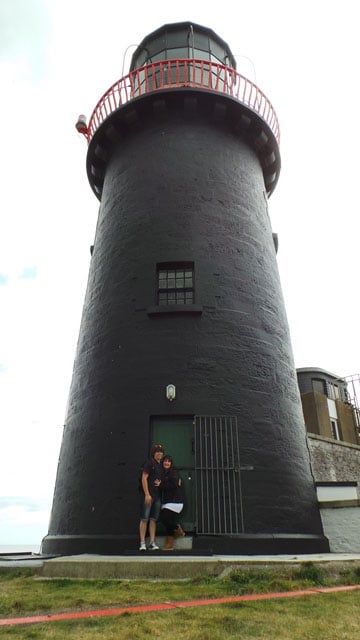
Happy couple back at ground level at Ballycotton lighthouse Ryan Johnson and Rebecca Daly on Ballycotton lighthouse
"Great to see romance is alive and well," said Derry Keogh, retired Ballycotton School Headmaster and local historian, who was the guide on their midday sailing trip to the island. "What a location to pop the question! When they heard about it, all the other tour visitors who were there gathered round and we sang 'Congratulations' - Phil Coulter maybe looking for royalties! This made it a double first for Ballycotton Island Lighthouse - the first ever sing song on the lookout tower!"
Since beginning in early July this year, the Ballycotton Island Lighthouse Tours have proved a great success with over 1,700 visitors hearing about the history of the lighthouse and seeing the view from the previously inaccessible lighthouse lantern balcony and island. This is an economic boost for the fishing village, both in profile and for local businesses.
VOLVO REPORTER
Irish sailing photographer and cameraman Brian Carlin has been appointed the Onboard Reporter with Team Vestas Wind for this year's Volvo Race. He has worked with the biggest names in the sailing world and on some of the biggest races.
Chris Nicholson, the four-time race veteran, who skippered Camper with Emirates Team New Zealand in the last edition of the race, will lead Team Vestas Wind, a campaign sponsored by Vestas, the Danish wind energy company. This is the seventh team in this year's Volvo round-the-world which begins with an In-Port Race on October 4 in Alicante, Spain.
SEAFOOD EFFICIENCY
And speaking about fishing and seafood which is increasing its attraction to consumers, retailers who sell fish are being urged to take part in a new scheme by Bord Iascaigh Mhara (BIM), the Irish Sea Fisheries Board, the State agency with responsibility for developing the sea fishing and aquaculture industries. This is the
"BIM Green Seafood Business Programme," aimed at assisting seafood businesses to reduce their environmental impact and save on energy costs. ""Making seafood processes more sustainable can improve a business 'bottom line' by reducing costs and enhancing their environmental reputation," says BIM.
In conjunction with Green Business and SEAI, BIM I are hosting a series of FREE, half-day seminars to assist Seafood Retailers. They will be held in Dublin on Tuesday, October 14 at the Radisson Blu Hotel, Dublin Airport; and in Cork on Thursday October 16, at the Park Inn, Cork International Airport. Advance booking is required as places are limited. For more information and to book, contact Lorraine O'Byrne in BIM on 01 2144185 or email [email protected]
Email: [email protected]
Twitter: @Tom MacSweeney, @AfloatMagazine
#strangfordlough – It's most encouraging to see such interest in the magic of Strangford Lough writes W M Nixon and if we missed out on some aspects of it in reviewing our time there (see blog and comments here), it was only because we had already so much material on the agenda of primarily dealing with the Rivers and the GP 14s.
I take Theo Rye's point that the Linton Hope-designed Dabchicks of 1895 were probably the world's earliest one design class with Bermudan rig, but would plead that I think I meant to describe the Rivers as the world's first one design keelboat class with Bermudan rig (well, he would say that, wouldn't he?).
As for William Jenkins pointing out that Glens were also racing that night of Wednesday August 13th, so too in a combined class were the RS Elites and Flying Fifteens. The Glens, like the Rivers, had good racing, but here too one boat was dominant, Glenlark sailed by Richard Aitken whose family have owned the boat from new, his crew including Irish Cruising Club Vice Commodore Alan Leonard.
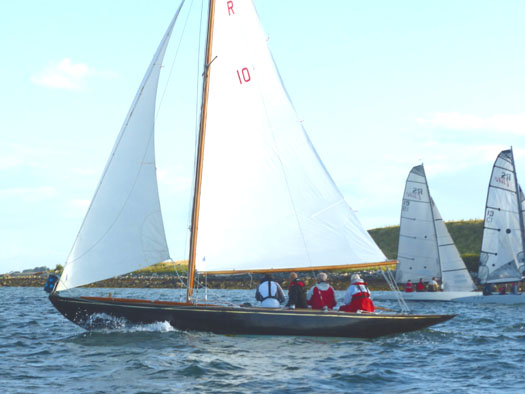
Two RS Elites shaping up for their start (right) closely watched for pointers for their own start by the crew of Brian Law's River class Uladh (foreground). Photo: W M Nixon

The SLYC Glen Class racing with Richard Aitken's Glenlark (right) well positioned on the favoured west side during the beat. Photo: W M Nixon
The Strangford Lough Glens are on something of a roll these days, as this past weekend (August 16th & 17th) they had their annual team racing series against the Dun Laoghaire Glens, and though it was an away match for the Whiterock squad which was captained by SLYC Commodore Ian Gleadhill, they won overall in a series which was curtailed by Sunday's foul weather.
As for the quality of the courses and the race management at Whiterock on the night of Wednesday 13th August, the photos speak for themselves. Racing started in a brisk and sunlit nor'wester, the course provided two excellent long beats and lots of spinnaker work, and it was all neatly wrapped up after sunset but with every boat finishing the course despite the dying breeze and gathering darkness. It was club evening racing at its very best, and the banter at the tasty post-race supper in the clubhouse rounded out an excellent programme.
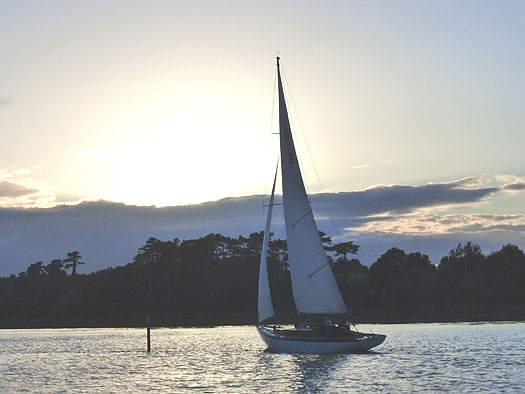
Evening racing timed to perfection. In the long-drawn-out northern sunset, Richard Aitken's Glenlark arrives in the lead at the weather mark. SLYC uses simple but clever ballasted plastic piping racemarks, and even when the tide is across them a displacement boat will find she has a very forgiving cushion of water between mark and boat when trying to shoot the turn. Photo: W M Nixon
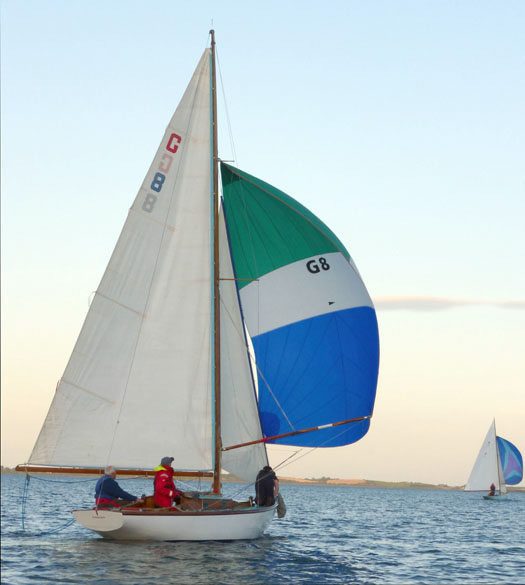
The last of the sunshine plays on the fields of the Ards Peninsula to the east as Glenlark consolidates her lead down the final run. Richard Aitken had read the beats so well he was up among the tail-end River Class boats. Photo: W M Nixon
Summit Says It Will Wake Up the Sailing Industry
#sailingindustry – The 13th International Sailing Summit (ISS), taking place on 17 November at METS in Amsterdam, will prove revolutionary for the industry by demonstrating that to succeed in a global market companies must diversify and innovate, say organisers. 'Waking up the sailing industry – how sailing needs to modernise, diversify and develop to attract and retain participants' has been announced by British Sailing, an association of the British Marine Federation (BMF), as the theme of the 2014 Summit.
This worldwide forum, bringing together the best in the industry, aims to drive change and promote sailing on a global scale. Broken-down into three sessions, each will address a need for modernisation:
"Diversification"
Speakers will identify the future target audiences which have evolved from today's global community , including amongst others Molly Winans, Spinsheet Magazine on "Changing Your Game Plan to Welcome Diverse Customers"
"Participation"
A unique chance to hear how experts within and outside of sailing have successfully driven participation in their sport. This will include observations from Terry Greenwood, British Cycling on "Learning from Another Industry – Growing Participation in Cycling"
"Innovation"
Speakers will demonstrate how and why modernisation and creativity is central to future prosperity for the industry. This will include a great insight from Philippe Fourrier and Philippe Bru, Ilago Event, on an incredibly popular & growing event "Defi Wind & Defi Kite"
The annual ISS has proven itself a prominent event for the forerunners of the sailing industry. After last year's Summit between 90-100% of attendees anticipated their return or endorsement of future ISS's*. In consequence, the 13th ISS is an event not to be missed to ensure your business is part of its future.
As Fiona Pankhurst, President of the British Marine Federation and Head of Corporate Marketing & PR at Raymarine enthuses "The International Sailing Summit brings together some of the world's leading lights with the experience, ideas and innovations required to help sailing develop and grow. We will be hearing from other sports about how they have faced and overcome challenges in order to grow, and will be learning about new technologies to encourage participation. For any company involved in any aspect of sailing, this conference is vital as part of your company's development, to see how you can grow your market place and to start METS energised with new ideas and solutions from the exciting panel of presenters and high profile after-dinner speakers. It's a not to be missed opportunity to benefit your business."
Baltimore Maritime Centre Receives Widespread Support
#westcorksailing – Balitmore Maritime Centre (BMC) was formed in 2013, in order to continue the sailing activities of Les Glénans in Baltimore, West Cork which have ceased. Here BMC chairman Michael O'Meara outlines the work of the centre since it started activities earlier this year.
Both Baltimore and Collanmore sailing bases have been put on the market by Fáilte Ireland. We have been unable to secure a lease on the Baltimore property as Fáilte Ireland are not engaging in that type of business activity anymore. However, we are keeping a watching brief on the sale of Baltimore and there are moves afoot locally to secure funding to make an offer to purchase the base. There has been widespread support for Baltimore Maritime Centre/Glenua in Baltimore and Skibbereen and this is very encouraging looking towards the future. We have ongoing liaison with local businesses and other interests.
On a more practical level, BMC/Glenua, in conjunction with the local maritime heritage group has produced a comprehensive proposal for the development and use of the base. This proposal encompasses traditional boat building, maritime archaeology and a maritime heritage data base whilst ring-fencing and enhancing our Les Glénans style sailing activities. The Baltimore Maritime & Training Project document is reproduced in our newsletter, The Beacon, attached for your information.
We are using this proposal in our engagements with state agencies, politicians and funding agencies. If this proposal is successful, it will give BMC/Glenua security of tenure, enhance the total sailing experience, have the capability of using the base all year round and provide a greater economic unit to make the project sustainable for the long term.
Our fleet of 6 GL 570s were re-located to Heir Island in June in order to provide keel boat courses in a very successful joint venture with John Moore of Heir Island Sailing School. The boats are now back at anchor in Church Strand Bay, Baltimore. More courses will be available during August. We have just completed our July cruising courses running between Kinsale and Baltimore and again, more of these courses will be available during August.
A copy of the BMC newsletter, The Beacon is attached below.
#islandnation – The sea moulds the Irish coastline, it lubricates the nation's economy, its exploration is a resource for scientific investigation, it provides adventure and leisure.
The sea which surrounds us also has the potential to be a cradle for national resources, with the power to feed and provide energy.
A national strategy, "Harnessing Our Ocean Wealth," was launched in 2012, intended to position Ireland to gain advantages from the global marine market, particularly for seafood, tourism oil and gas, ocean energy, to a predicted value of €1.2 billion. The Naval Service has got a new ship, another is under construction. There is a National Maritime College and the Beaufort Centre of IMERC, the Irish Maritime and Energy Resource Cluster, on the College Campus will "promote Ireland as a world-renowned research and development location, that will unlock Ireland's maritime and energy potential," according to its own description. These are some of the positive developments.
So has the Government overcome the "sea blindness" which has pervaded national policy for many previous years?
Benjamin Franklin wrote of a "little neglect" creating greater problems and, though his remarks were aimed at other than maritime affairs, they are apposite to quote in relation to marine matters.
Why is it that an island nation does not have a dedicated maritime department of government and that aspects of the marine sphere are spread around so many departments that the high level which marine affairs should be at has been so diffused? This, despite pre-election promises by Coalition parties, that maritime affairs would have the highest priority and all of them would be brought under one Department.
That would seem to indicate that pre-election promises are just political guff by those who "say anything, comment on anything," to get into power and stay there!
Over 95 per cent of all exports and imports to this island are moved by sea and every import and export has to cross the sea, even the small percentage carried by air. Nothing can enter or exit the country without crossing over the sea.

So why is the marine sphere not a primary focus of national policy?
The power to feed from the sea was given away by failures at the highest levels of political and civil service to realise how important the fishing industry should be to the future of the nation, when the vast wealth and resources of Ireland's waters in fishing were conceded to the power of the European Union.
Two natural gas finds, at Kinsale Head and the Corrib, have not and do not show signs of, producing wealth for the Irish people. From Kinsale, Ireland did get supplies of natural gas and a supply network, but the nation - the people of Ireland - paid for it while profits from the finds went to the exploration companies. The same looks like happening in the Corrib. The Government does appear to have changed its attitude, with new requirements announced for any future offshore discoveries of oil or gas, but it has come somewhat late to acceptance of the depth and breadth of Irish marine resources.
Raising public awareness about the maritime sphere in Ireland is crucial. This is relative to all aspects of the marine sphere from commercial, industrial, employment potential to leisure.
"Sea blindness" has pervaded political life for many years.
But it was not evident amongst early leaders of the nation. Arthur Griffith argued for a strong fishing industry and emphasised how vital it and the marine sphere would be to Ireland in the future. The Government during World War Two, realised the accuracy of that summation when, isolated despite being a neutral nation, it had to establish a national shipping company to supply vital needs. The liquidation of that company, the abandonment of seafarers, the disaster visited upon the fishing industry and coastal communities by the failures to realise its importance, neglect of ports and safety policy for many years were and in some cases remain as indicators of State neglect.
The fine weather has underlined the importance of the sea, as people went to the seaside; the problems of pollutants from landward into the sea and rivers has caused difficulties and perhaps given people some increased appreciation of the importance of the sea and protecting it.
Public awareness of the sea is crucial, to pressurise politicians, a group which, in the main, has failed to contribute positively in this regard. National media coverage of maritime affairs is abysmal, apart from tragedies and controversies.
There are Irish politicians who should be ashamed of themselves for their attitude to the marine sphere in past years. I cannot forget doing an interview with one of them, who came from a family with a long political heritage and who had just been appointed Minister for the Marine and who told me, as he thought in avuncular fashion and that it was a joke: "I'm the Minister for fish and ships, but we have to suffer a bit in political life to get on." When I asked if he would repeat that comment on the record, he got rather nasty and didn't like when I said that I respected seafarers and fishermen, but doubted his attitude, from what he had said about his department which seemed, to me like disrespect of the importance of maritime matters.
"Well, it's not the highest appointment I could have got," was the huffy reply.
I have attempted to make the case for an Irish Maritime Foundation, which would be founded to raise awareness of marine matters, encompassing all strands of interest, which would be a maritime platform, with public, private and State involvement.
Ireland's maritime resources, our maritime heritage, the island nation in which we live, deserve this.
There should be a dedicated Department of the Marine, encompassing all aspects of the marine sphere and the Minister of that Department should be regarded as a major posting in Government.
That would recognise that Ireland is "an island nation."
The public have a role as the guardians of Ireland's marine resources.
SAILING DECISIONS
I wrote a few weeks ago about my interview with David Lovegrove, President of the Irish Sailing Association and the review of sailing and if the association which he is leading. He impressed me with his fresh, innovative thinking and determination. Sailing also needs higher public awareness.
I was in Carrigaline Library in County Cork when a man approached and told me how he very much wanted his son to go on an ISA Training Course, but he could not afford the club membership which would be necessary before his son wold be accepted and that, coupled with the cost of the course itself and, perhaps, a boat to use, it was all beyond his resources. His young lad, of 11, was with him. He had been at a football summer camp, which cost €80.00 and his father wondered why sailing clubs did not provide something similar and not just the courses which he considered expensive.
I did explain about courses at sailing schools and about the costs which clubs had to meet to run courses, but his experience does make a point. Is there any prospect of a 'summer camp" approach without high costs, for those who would like to be involved, but can't afford formal training courses in these present times?
A related point is for those who would like to crew on boats, but cannot afford club memberships and probably would not use a club facilities for other than on one night's racing a week.
These are aspects which could be looked at to address declining numbers.
As this man said to me: "You say that sailing is a sport for all, but I don't see that."
Affordability is an issue because other sports are cheaper to become involved in.
I hope that this will be addressed when the result of David Lovegrove's work is revealed later this summer. I gather that also discussed by the ISA board have been how sailing can be given a 'community involvement' aspect, preserving the 'lifelong sport' approach which, in my view, should be a major attractive point and sailing's unique capacity for family involvement; how to relate cruising and racing, the fragmentation of the sport into so many classes of boats; and how to relate club and local sailing with high performance.
There are a lot of issues, another of which of course is the media attitude towards the sport. It remains noticeable how little regular, concentrated attention, it is given by the national media.
FIRST WORLD ANGLING MEDAL FOR IRELAND
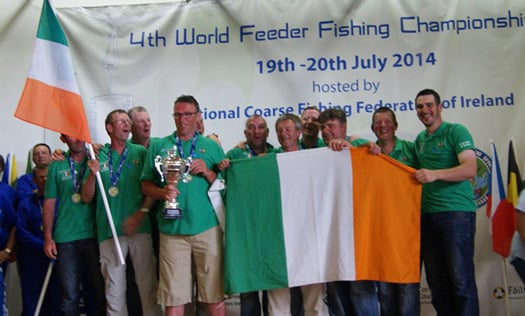
It is good to see another Irish marine success, a historic achievement for Irish coarse anglers. 125 anglers from 25 countries were in Coachford, County Cork, for the World Feeder Fishing Championships. Going into the competition the English team was the favourite. They had visited the venue a number of times in advance of the competition as part of their preparations! "The Irish finish was especially satisfying," Paul Bourke of Inland Fisheries Ireland told me, "as it is the first team medal in a world championships." Congratulations go to Francis McGoldrick, Richard Pratt, Tony Kersley, Paul Leese, Nigel Houldsworth, Ken Ince, Brenton Sweeney– Captain and Roger Baker– 2nd Captain.
DIVING TRAGEDIES
Though I am more involved in being "on the water" rather than in it and prefer things that way, I appreciate the under-the-surface beauty of Irish waters and the sport of diving, amongst the fraternity of which I have many contacts. The deaths of six recreational underwater divers since June have been of deep concern. It is not an emerging trend of fatalities in the sport, according to the Irish Underwater Council which has urged diving enthusiasts to ensure that they are medically fit to dive and that their equipment is serviced at regular times and is in good working condition.
MARVELLING AT THE OPPIES

I remember one night at the RCYC when there was a discussion about whether it was a night to go sailing as the rain fell and it seemed the wind would be increasing.
I looked out from the clubhouse and there was the Optimist fleet, with the young sailors putting out for their racing/training. That ended the discussion and off we went! There are times when I look with appreciation and some awe at what conditions the Oppies can handle. Sometimes I wonder if they are being exposed to too much, as I did in the cold and wet at Baltimore in West Cork earlier this year in what seemed like mid-Winter days when there were Oppies from, it seemed, all over the country for a training session. But the Oppies seem to manage it all.
There is just over a week to go until the closing date for entry to the Optimist National Championships at the RCYC. Doug Howlett will officially open the CH Marine-sponsored event which will start on Thursday, August 14. Details on www.oppienationals.com or by emailing [email protected]
GREENPEACE FOLLOWING COSTA

Greenpeace has been following the towing of the Costa Concordia from Giglio to Genoa, because of its passage through what it has described as "one of Europe's largest marine sanctuaries."
"We're particularly concerned about impacts on the Pelagos sanctuary, which protects whales and other marine life in the area," said Greenpeace.
The Pelagos Sanctuary for Mediterranean Marine Mammals is a protected area of 87,500 square kilometres in the north-western Mediterranean covering much of the towage course. The decision to tow the Costa Concordia to Genoa was approved by the Italian Government prior to the start of the re-floating operation and was based on that port's ability to perform the demolition work.
NEXT THIS ISLAND NATION RADIO PROGRAMME HERE ON AFLOAT: August 7.
Facing Up To Irish Sailing's New Realities
#irishsailing – Ireland is having a busy sailing season through 2014, but there is concern about the decline in turnouts in some major events. W M Nixon suggests that, during the years we've been pre-occupied with weathering the economic storm, we may have missed the fact that the basic structure of sailing is changing.
We've lived through interesting times, these past few years. And with Ireland's particular woes during the global financial crisis, the general lack of money and resources, coupled with the decline in simple enthusiasm for living energetically and enjoying participant sport, has obscured the fact that sailing – like most sports – has been changing, with an increasing emphasis on focussing attention on a few big professional events, rather than celebrating the small and the local.
A clear case in point was the visit of the Clipper Race to Derry/Londonderry, which coincided precisely with the weekend at the end of June when the biennial Round Ireland Race was staged from Wicklow. Although there were many entries racing round Ireland which had varying levels of what we might call soft sponsorship, essentially it was an unsponsored race for amateurs run by amateurs, something to which the mass media will give little if any attention.
But the Clipper Race by contrast is now a firmly established commercial venture based on a sound business model. Robin Knox-Johnston has certainly earned the event's success with his dedicated promotion of the ideal over the years, and the main sponsors – whether they be major brands, cities, regions or even countries - feel very comfortable with it. This is a corporate affair where all the big decision makers can be confident that there'll be a highly professional output of good human interest news stories. And if a television company sends down a film crew with a reporter to cover the stopover, the Clipper Race's own people will know exactly what they need, and thereby maximise their expensive time to produce newsworthy results.
As for the non-professional paying crews taking part, they're fully aware that they've divvied up the kind of money which would buy them their own very useful little boat if they so wished, and have a bit of money left over to run it too. But they much prefer to pay up front for what they know will be the sailing experience of a lifetime, all neatly packaged and ready to go, and everything done and dusted at the and of it.

Derry/Londonderry/Doire arrives at the entrance to Lough Foyle to win the Clipper Race's Transatlantic leg.
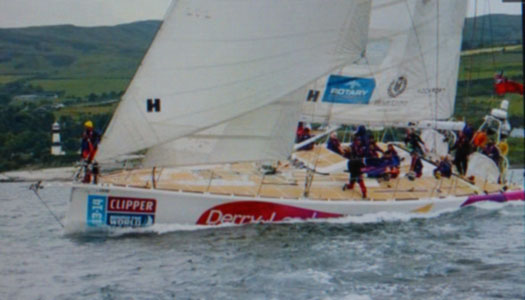
Home to victory – DLD making knots up Lough Foyle past the coast of Donegal
When the various pay-up-front round the world races were establishing themselves several decades ago, one noted newspaper sports editor famously agreed that they were the sporting equivalent of a fleet of tour buses full of paying passengers racing down the road from Dublin to Killarney. My own feeling was that a tour bus race would actually be great fun, but I could see the point that it was remote indeed from the purest concepts of sport.
Nevertheless the round the world operators have been whittled down over the years until the Clipper Race not only survives but actually thrives mightily, and has an image to die for. Far from being a specialised oddity, it is becoming mainstream. In Australia, the annual Sydney-Hobart Race struggles each year to get its entries above the hundred mark, so when the Clipper organisers suggested they might make Sydney-Hobart 2013 a leg of their course, the organisers – the prestigious Cruising Yacht Club of Australia – leapt at the chance. And as far as we're concerned in Ireland, it was a great success, as the Irish boat Legenderry, skippered by Sean McCarter of Donegal, was the winner of the Clipper division, while it was noted with added satisfaction that his hefty big "tour bus" had by no means been beaten by all the fancy out-and-out racing machines sailed by Hobart race veterans.

Sean McCarter aboard DLD – his class victory in the Sydney-Hobart Race made him the Afloat.ie "Sailor of the Month" for January.
But even in the best of all possible worlds, there is only so much in the way of resources for such events, and public attention is very limited and fickle. Yet in the end, public attention is what motivates sponsorship. For sure, in a small, specialised and intensely personal sport like sailing, there will always be a willingness by some company bosses to give a bit of help to a friend organising a sailing event. But at the very least it has to be something which can in some way be justified on the balance sheet, and with the increasing dominance of the ubiquitous accountant, and his or her need in turn to justify aspects of the company's behaviour to the tax inspectors, the old "helping out a mate" approach to sailing sponsorship becomes increasingly difficult to justify.
Yet although almost all sailing enthusiasts will give a bit of their attention to events like the Clipper Race and the Sailing Olympics, while even the most hidebound traditionalist will occasionally take a furtive note of what's going on in the snakepit of the America's Cup, the fact is that for most of us, sailing is still primarily a matter of sailing our own boat, or crewing with old shipmates on someone else's craft, and taking part in club racing and local regattas which to us are the essence of the sport.
But in terms of outside attention, even in the town or village attached to our own home ports such beloved sporting activity scarcely registers at all in a world in which round-the-clock sporting highlights are available on the media or in a nearby stadium virtually all the time.
Most of Irish sailing is all about what Edmund Burke called "the little platoons". While Burke recognised the inevitable and growing power of the big battalions, he promoted the ideal of the vital function of the little platoons – basically the family unit, the extended family, and their circle of friends – in holding society together and preserving civilised life.
So instead of mindlessly banging the drum about Ireland being a great place to sail, and endlessly repeating the mantra about the Royal Cork being the world's first proper yacht club – true and all as both may be – perhaps it's time to be realistic about our sailing situation, cherish what we have, and thereby build it to a healthy state.
Admittedly if you go overboard on being realistic, you can quickly become pessimistic and reduce all home sailing activity in recognition of the fact that many people's sailing ideal is a warm and sunny fortnight in Croatia or the Greek Islands, sailing boats whose care and maintenance is someone else's responsibility, and sailing moreover on waters which won't give you hypothermia after an hour's immersion.

The legendary American offshore racer Carina rounding the Fastnet Rock in the race of 2011. Carina will be one of many contenders in the Fastnet Race of 2015, but like most of the large fleet, it's unlikely she'll enter any Irish port.
But the perception elsewhere is that Ireland is quite a rugged place to sail. In fact, for many who briefly sail in our waters every other year, the ruggedness of our waters is the USP of the Fastnet Race. The biennial Grand National of offshore racing is now the epitome of a "big battalions" event. With the added kudos of the 1979 disaster in its history, having a Fastnet Race in your sailing CV is a globally-recognised distinction. Thus we can be quite sure that next year's race will see the enormous but limited entry list filled almost instantly, and equally we can be sure that the Irish economy will scarcely benefit at all from a huge event which uses our most iconic rock as the main mark of the course, the very symbol of an entire vast international event, yet the race starts and finishes in the south of England.
As to the perception of Ireland's weather and our sailing conditions, ten days ago I was up at Ballyholme Bay on Belfast Lough for the annual F18 World Championship. The F18 is a hugely popular catamaran which thrives as a class where sailing waters are in easy reach of large populations. Thus its biggest fleets are along the north and northwest coasts of France, but it's big in Holland and Germany too, and in the south of France and Italy it prospers mightily.

Belfast Lough produced some fine Irish summer sailing weather for the F18 Worlds, and at the same time the F17 Worlds in the south of France were being disrupted by severe gales. Photo: W M Nixon
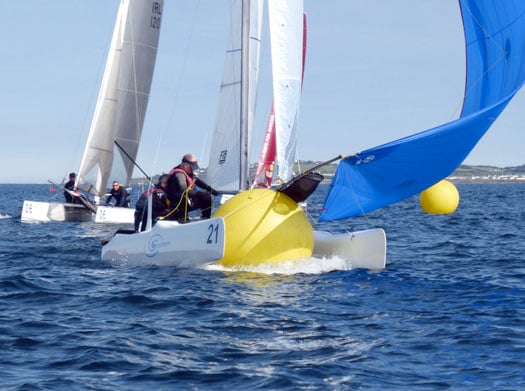
Whoops....it may have been a World Championship, yet there were some very human errors. But then, anyone accustomed to sailing a monohull could very easily forget you've a second hull to lee. Photo: W M Nixon
The 2013 Worlds in Italy attracted a fleet of 170 boats with thousands attending the opening festival. Then, as the well-run class has a policy of rotating the Worlds around countries which have a significant presence of F18s, the fact that it's the biggest catamaran class in Ireland saw the 2014 Worlds allocated to Ballyholme, Northern Ireland's premier dinghy club and a stronghold of F18 racing.
They knew that it would be wildly optimistic to expect a fleet to match Italy's lineup of 170 in 2013. But a target of a hundred boats seemed reasonable. Yet in the end they got 56. They'd great racing – much better than their smaller sisters the F17s which were being blown out of the water at the same time at their Worlds in the south of France. And with Gunnar Larssen of the Netherlands winning the title at his 13th attempt, there was a popular winner for a keen class of very pleasant people who were interesting and fun to be around.
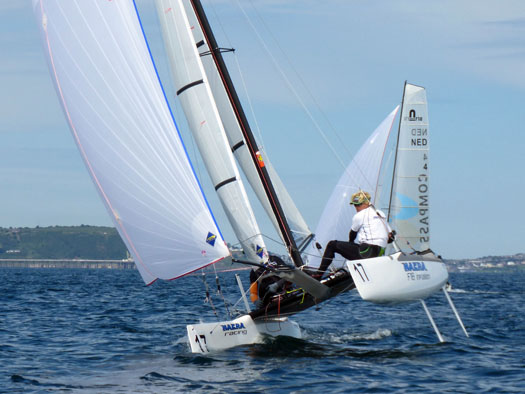
The F18s can be powered up in light breezes if you can get the weather hull clear.........Photo: W M Nixon

....and as the breeze builds, the hope is to have both crew on the wires......Photo: W M Nixon
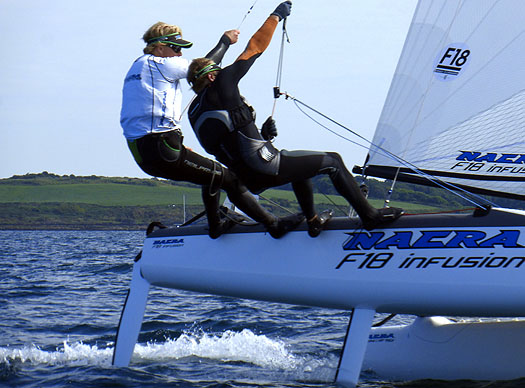
.....and then you're really cooking with gas. Photo: W M Nixon

It can be a knife edge. This may all look very relaxed, but it happened in jig time. Photo: W M Nixon
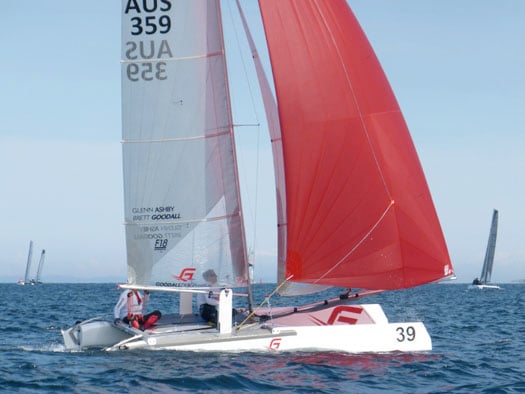
America's Cup rockstar Glenn Ashby of Australia was in the frame from time to time, but boat damage hindered his campaign. Photo: W M Nixon
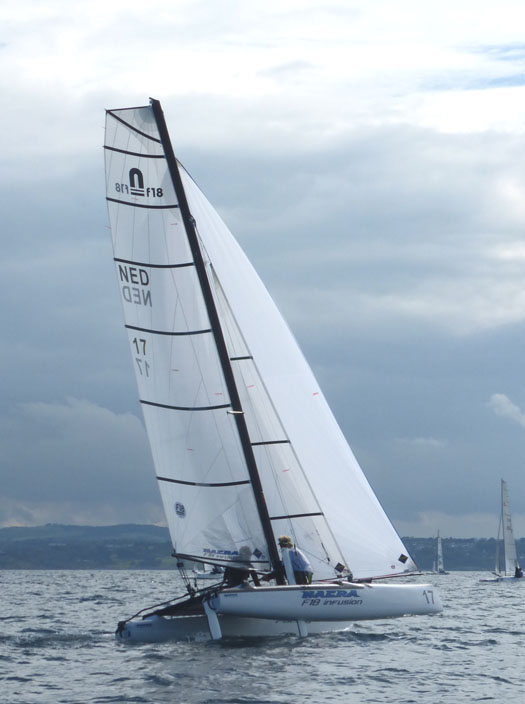
Despite his Viking name, new F18 World Champion Gunnar Larssen is Dutch. Here he gives a masterclass in winning out on a dead run (yes folks, this IS a dead run, but F18 style). Photo: W M Nixon

It was as the fleet came ashore that you realised the international nature of the entry. And the weather was Mediterranean, while in the Med itself, it was blowing a gale.....Photo: W M Nixon
As for a fleet of 56, it's more than enough to provide good sport, and they certainly had it. But it was a chilling – in every sense – reminder of the fact that, ever since Roman times, Ireland has been seen by the rest of Europe as Hibernia, the Land of Eternal Winter, and thus for the modern sailing world in general, we're seen as a small and distant island where only the most rugged would dream of going upon the sea.
Perhaps the turnout in any international event here could be directly calculated in relation to the distance of the venue from Mediterranean sailing conditions, qualified by the distance from Europe's main population centres. And lest anyone think that this compact turnout at Ballyholme was essentially to do with the special circumstances of Northern Ireland, at exactly the same time Cork Week saw numbers hovering around the hundred mark. And this in an event which fifteen years ago used to soar above five hundred.
It's a forceful reminded of how our sailing times are changing. If something is going to be very big in every way, then it can take up a lot of time and energy. But the old days of private owners divvying up resources and chivvying up crews in order to do a distant medium size regatta with all its logistical challenges seem to be a thing of the past, as the Scottish Series has also been finding out.
Yet if you visit every corner of Ireland, you'll be pleasantly surprised to find that on every coastline, any good anchorage is well filled with boats. After six years of economic stagnation, they may not be the newest boats around. But they're there in apparently greater numbers than ever, and they function happily in a strictly local environment.
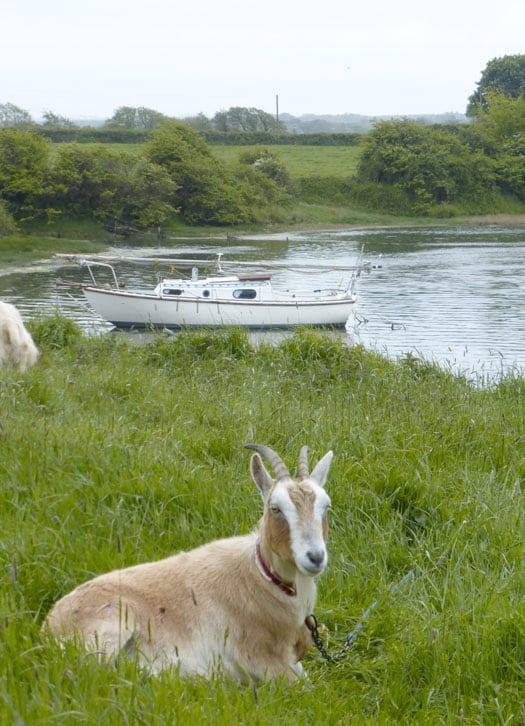
Ireland's hidden fleet (1). While getting a snap of this splendid goat at Ballylongford on the Shannon Estuary, we found our photo included a Macwester sloop, part of the growing local fleet in this remote inlet. Photo: W M Nixon
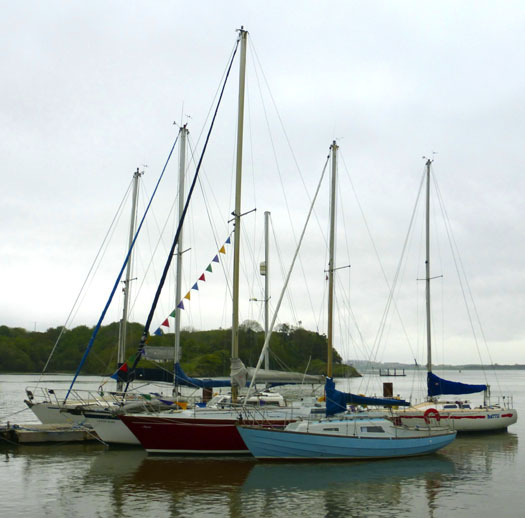
Ireland's hidden fleet (2). The cruiser-racers at Foynes YC have steadily increased in number for several years. This group includes two Irish-built boats on the right: an O'Brien Kennedy-designed Kerry, and a Ron Holland-designed Shamrock. Photo: W M Nixon
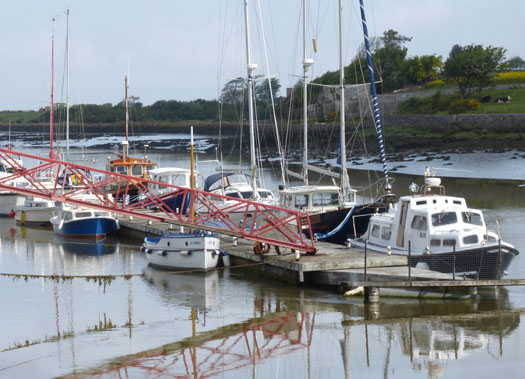
Ireland's hidden fleet (3). Up and down the Shannon, everyone will know of Askeaton in County Limerick, and Cyril Ryan's busy boatyard there. But who in the big outside world knows that this muddy creek is home to a fine fleet? Photo: W M Nixon
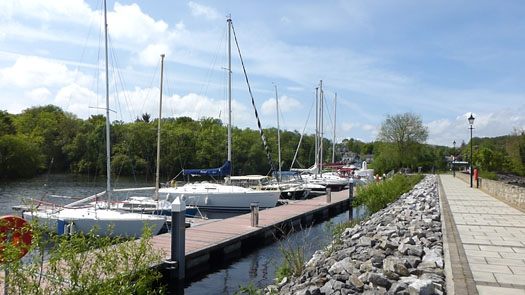
Ireland's hidden fleet (4). Talk of sailing on the Shannon lakes, and most folk will think of Lough Ree YC or Lough Derg YC, plus Iniscealtra SC at Mountshannon, and that's about it. But the extended harbour at Garrykennedy in Tipperary also has a fine fleet which wouldn't look out of place in a seaport. Photo: W M Nixon
It's something which will never be a headline-hitting sporting sensation, this quiet sailing enthusiasm of the little platoons. But it's there nevertheless, and as economic recovery picks up, who knows but we might be able to build it up into a slightly busier and better-supported sailing programme based on a realistic appreciation of the fact that while we may be a reasonably-sized island – the 30th largest in the world, to be precise – we're sparsely populated, we're relatively remote from the very big places, and we sail in a climate which can be rugged enough.
But as things get moving again, let's be realistic. There are grants available for clubs which wish to expand or develop their facilities. However, the message is: Don't simply think up some wizard scheme just to be able to avail of a grant. Instead, be realistic about what your really club and its membership really needs, and then -further down the line - see if it may be eligible for a grant. Such an approach will be to the benefit of everyone, and will help to build sailing's true image as a participant sport for all who are genuinely interested.
Who Is To Blame For The Decline in Sailing?
#sailing – Sailing is a sport, not the qualification of a superior social standing.
Is that fully understood by everyone involved in the sport or is there still an element of elitism which needs to be eradicated?
The term 'yachting' was dropped a few years from the title of the national representative organisation which became the Irish Sailing Association, amidst an apparent belief that 'sailing' would be less elitist as a descriptive term and more acceptable to the public.
Most 'yacht' clubs did not become 'sailing' clubs, though there are more 'sailing clubs' it would seem than 'yacht' clubs around the country. Boats did not generally become described in the American term of 'sailboats' but remained yachts.
I see no major problem with the term 'yachting' though I understand the sensitivities which surround the different terminology. I have no qualms about admitting that I own a yacht and feel fortunate to do so.
What is of more concern to me is that the sport becomes truly a 'sport for all' and is not riddled with different levels of social strata.
There remains a degree of public perception that sailing is an elitist sport. This has dogged it gaining more general acceptance and bedevilled its reputation.
Sailing, or yachting, should be a 'sport for all' in an island nation where it is based on access to the magnificent resource of waters surrounding us.
The perception of wealthy people with big boats, sitting in clubs behind signs of 'strictly private', is not conducive to creating a widely popular sport. There is a dichotomy here because the growth of interest amongst young sailors, with more involvement in dinghy sailing such as through Optimists, has been encouraging. So has the advent of more interest in schools in adopting sailing onto their sports curricula.
The movement for change within the ISA came initially from the dinghy fraternity, where many of us who now sail cruisers, began their love affair with the sport.
The breakthrough which sailing needs, to gain more general popular public acceptance, has not been made.
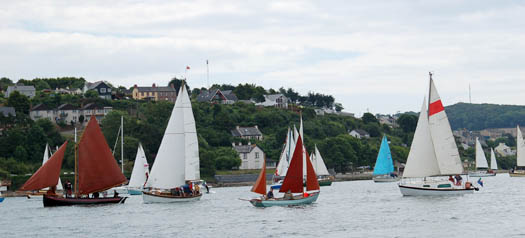
People sail boats of all types
Why is this?
Throughout my years of being a marine journalist and when marine correspondent within RTE, it was difficult to get coverage for sailing. I did achieve it, but there was always a bit of a battle to establish acceptance that the sport was not just for the wealthier part of the population, but that it permeated across all social milieu. I did get that message across by quoting figures of how many are actively involved in a day's racing organised by major clubs, compared with the attendance for example at some Irish soccer matches which got plenty of media coverage. I also stressed that it was a participative sport more than a spectator one. More people within the broadcast service have become involved in the sport. But generally in the media, there is still an impression that sailing is a sport for which you need a lot of money and this is perpetuated by the oft-quoted unfortunate analogy of standing under a cold shower and tearing up money.
But sailing – and yacht – clubs are also contributors to this failure to get the message of sailing as a sport for all across. In my experience as a journalist, most clubs are poor at their public relations and the issuing of information to the press, but yet complain that the sport does not get enough coverage, even if they do not provide the information. There are honourable exceptions, who provide good circulation of information and websites, but there are many other clubs who are pretty bad at sending information and whose websites are dismal failures, not updated for long periods of time.
At the annual meeting of the South Coast Offshore Racing Association in Kinsale Yacht Club in the Spring one participant told the audience that "yacht clubs to most people would be the scariest places to walk into."
Another said: "It is no wonder that we struggle as a sport to keep people as lifelong participants, even though we can and do attract younger people into the sport at an early age."
The warning signs have been there for years, for those who wanted to note them. Sailing needed to widen its appeal, to get more people into the sport for lifelong participation.
To survive a sport needs an organised structure and clubs are needed to provide this, they must have members who pay to join and support them. They cannot exist if people use them without joining and therefore not giving on-going financial and volunteer support.
So there is a dichotomy here. Why are clubs not getting enough members, a situation which appears widespread?
The economy over the past few years has undoubtedly been a contributory factor. People have lacked disposable income and, amongst families in particular, expenditure on non-essential matters has had to be cutback. Some clubs have responded with different arrangements for membership, but as I wrote in this blog last week, I still think that new, flexible approaches are needed, particularly to encourage crews, of which most active racing boats are short.
There are also people who sail and who do not join clubs, either they don't want to, or can't or there are not clubs close to them or for whatever reason. But they do sail, are they outside of the system and should they be considered. How can they be appealed to because they are involved in the sport. There are the traditional boats and the huge support they get. Some are members of the ISA, some of clubs, but many not so perhaps. There is a huge level of support for sailing in this sphere and many organised events which draw big support. Should the ISA reach out to these sailors, to this area of sailing activity?
This and many other aspects merit consideration to band together all interested in sailing, in all its facets. United in approach there would be a strong force which official authorities could not ignore when improved facilities and recognition are sought or when government and officialdom has to be challenged, such as in the imposition of new regulations.
On this month's edition of my radio programme, THIS ISLAND NATION, (click to play podcast above) I talked to the President of the Irish Sailing Association about his plan for a Strategic Review of the sport to deal with a decline and he accepted my suggestion that the impression of elitism is not good for the sport and has not helped its expansion and development. We also discussed whether there was too much concentration on racing and whether more support should be given to other forms of sailing, encouraging cruising.
David Lovegrove wants to get across the message that sailing is open to everyone. He would be particularly happy, he told me, if he could get that understood and accepted widely in public. We discussed how sailing can be a sport for all ages and for all people, with the uniqueness of enabling families to participate together if they wished. He recalled the time when he first got involved in sailing and the enjoyment and sense of friendship that abounded. Perhaps too, we agreed, there was less concentration then on being winners in racing and in high performance levels.
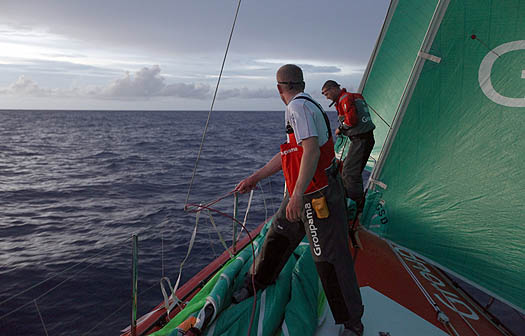
Ocean racer Damian Foxall of County Kerry
I think there is a need for Ireland to have a good presence on the international scene and that it is good for the country. It is also good for sailors to aspire to the highest levels of achievement, but have we got over-committed to competition to the detriment of the enjoyment of participation, of being on the water. Had the ISA also been too focussed on its own high performance programme and those who qualify for it and not given enough support to other sailors who may not have made it through the ISA system, but want to try on the international scene and should there be arrangements to support that. Also, for example, has the ISA been close enough to the top international sailors who have come from Ireland and sought to include them and utilise their services in promoting Irish sailing, such as Damian Foxall and Justin Slattery and where is the ISA in regard to the efforts of such as young David Kenefick making his own way onto the international scene through the Figaro Race.
All of these are interesting points to debate.
I take part in club racing, but I always try to make it clear to the crew that we are going out to enjoy ourselves and winning is not the overall aim, though it would be nice and we have been fortunate enough to do so from time-to-time. I don't like shouting on a boat, though sometimes getting something done quickly when needed can raise the vocal level. But if the enjoyment is taken out of the sport, that is not for the best.
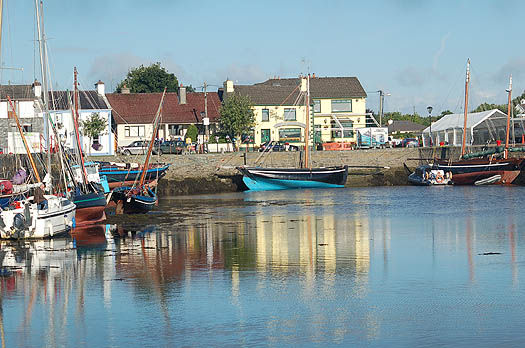
All forms of sailing need to be engaged
Again, here we have a dichotomy, other sports are hugely competitive-oriented, why should sailing not be?
There are issues to be addressed and I wish David Lovegrove and his team every success as they try to come up with answers. He told me in our interview, that this would not be a short-term solution, but would take a lot of work and commitment by the clubs themselves. Indeed. As I wrote in this blog last week, encouraging participation is essential to arrest decline. That will mean more innovative ways of involving people, a point which Denis Kiely, who has given tremendous national service to sailing made at that SCORA meeting in Kinsale and which impressed me.
He said that often crews did not get enough of a proper introduction to the sport, didn't have enough knowledge of it and weren't given such, didn't get training, could therefore feel unwelcome and then leave the sport.
Club marinas are pretty full of boats around the country, so it is at times hard to accept that there is a decline in participation, but the meetings which have led to the new approach by the ISA have shown problems, including dissatisfaction with the national association itself. David Lovegrove has accepted this and the need for change.
He spoke to me of his enthusiasm about the work ahead to re-define the sport and his confidence in the team he has appointed to oversee different aspects of the sport and to suggested changes. These are outlined in detail in the current/Summer edition of AFLOAT magazine.
His determination to create a strong, vibrant sport, is welcome. I wish him success with his efforts. Listen to his interview in my programme here on the Afloat website (above). Everyone interested in the future of our sport should respond positively. That commitment is what the sport needs.
So – who is to blame for the decline in sailing – all of us are, if we do not make changes to encourage more people into the sport and to stay in it and if we do not adapt existing systems to ensure they feel welcome. That means all of us who want to see sailing being a sport for all accepting that sailing is just that - a sport - not a badge of social approval.
#irishsailing – After five years of economic contraction, there are signs of recovery, and the 2014 Irish sailing season has also got off to a flying start. W M Nixon looks at various signs of new energy and initiatives, and sees how they might be affecting stories which have been run on this blog and in the Afloat.ie website during the past year. But he concedes that further cost reductions will be necessary for the good of the sport.
A year ago, any talk of green shoots in Ireland was almost entirely metaphorical. And it was in the economic sphere, though even there they were still few and far between, with many soon stunted. But out in the farmers' fields themselves, out where the grass should have been growing, there was scarcely a sign of life as we were still trapped in the coldest and most miserable Spring in living memory, and all forms of growth and recovery were blighted by it.
Sailing and boating, of all sports, are the most affected by Ireland's climatic conditions. Not only is the mood among participants strongly influenced by weather which sometimes can get anyone down, but without reasonable breezes, sailing events are seriously impaired. "We got a result!" may well be the PRO's final desperate claim after pulling some sort of a points table and leaderboard out of a series bedevilled either by too much or too little wind. But it's so much better to have a series bathed in sunshine and blessed by fine breezes, with enough races sailed for the crews to go home tired but happy without needing recourse to any of those weasel words which show you're only trying to justify a weekend of frustration.
Things could not be more different this year. The Spring of 2014 has been perfection, boats are going afloat on time and in reasonable weather conditions, and the first little crop of events and results are very encouraging indeed - so encouraging, in fact, that "little crop" doesn't do them justice.
That said, two of the nearer events which gave special cause for Irish celebration did not have perfect weather throughout. The Youth Sailing Nationals at Howth may have ended on a high with a great breeze in an early taste of summer sunshine, but one day out of the four was lost to bad weather. But the sting of that was lessened by the decision for "no racing all day" being taken at 1100hrs, which allows other leisure options to kick in.
The IRC Easter Championship in the Solent concluded through Easter Monday literally with "Darkness at Noon" – the heavy clouds and torrential rain on an almost windless day saw the final races being sailed with nav lights on. But there had been excellent racing on earlier days, and a very excellent result with Anthony O'Leary's Ker 39 Antix from Cork the clear supreme champion.
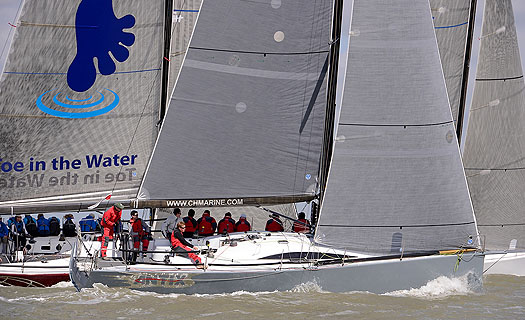
Doing the business. Anthony O'Leary's Ker 39 Antix settling into the groove on the way to the top place in the Easter IRC Championship. Photo: Rick Tomlinson
That in turn augured well for Ireland's Commodore's Cup chances, which then received a further boost last weekend when the crew of another Irish team wannabe, Quokka with Michael Boyd and Niall Dowling, had a winning weekend in the Warsash series with their temporary mount Tarka in anticipation of Quokka's return from the Caribbean at the end of May.

The Colours Match team racing between UCD and Trinity served up top sport in the Liffey, with Trinity winning. Photo: W M Nixon
Meanwhile the universities racing has been brought to life, for although UCD had a convincing win in the racing with the SailFleet J/80s to become the Irish team for the Student Yachting Worlds in France in the Autumn, before April was out the Colours Match in the Liffey under the burgee of the Royal Alfed YC, team-raced in Fireflies, saw Trinity take the honours in convincing style.
But if we're looking for something which really did set things freshly alight, it was out in Hyeres where the ISAF Championship saw the northern duo of Ryan Seaton & Matt McGovern take silver in the 49er, almost immediately moving them up the global rankings from 33 to 11, a quantum leap and no mistake.
The potential for serious success by these two has been fairly obvious for some time, but anyone who sails boats will know only too well how many factors have to come into alignment to get you up among the magic metals at the end of the day.

Stars of the silver sea – the Seaton/McGovern team took a silver medal for Ireland at Hyeres.
That their new global status was almost immediately acknowledged by this rankings improvement will in turn add heft to everything they do and say. Thus when, some time ago, the Ryan/Seaton equipe suggested that the 2016 Olympics sailing waters in Brazil are so off the standard as to be a health hazard, it attracted polite attention. But now that they're Number 11, and still counting down, much more notice is taken. And the fact that the Vice President of the International Olympic Committee has suggested, with something approaching despair, that the facilities in Brazil just aren't going to be ready for 2016 at any standard, all gives added legs to the statement from Ireland's 49er crew.
This in turn makes us wonder where world sailing might go in 2016 if the Brazilian setup is still Work in Progress. With tongue only slightly in cheek, we suggest they need look no further than West Cork, where Baltimore Sailing Club has been expanding its facilities to meet increased demand as a club which last year introduced something like 700 people to sailing. That BSC and current Mitsubishi Motors "Club of the Year" Kinsale YC further east along the West Cork coast have both been putting in premises up-grade during the past year, while other clubs have been having it tough, and just about hanging in there in some cases, surely gives pause for thought.
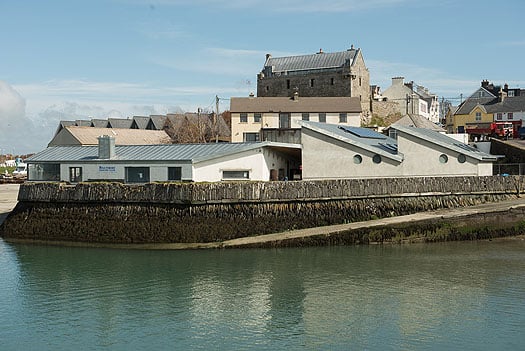
Olympic venue? The extended and up-graded Baltimore Sailing Club is ready and raring to go.
The economic shakeout of the past five years has caused a massive write-down in the value of almost all property and other assets. And in the case of yacht and sailing clubs, there has been a detailed examination of the continuing validity, or otherwise, of established yacht clubs and their traditional business model of quite high subscriptions under-writing other facilities which in turn combine to provide the complete package of an orthodox yacht club.
Inevitably, most clubs are run by officers and committee members who have been involved with the club for many years. Thus, like people who have been running a quality hotel for decades, they may have an inflated notion of what their organisation and its premises are actually worth. Admittedly there's only limited usefulness in comparing a yacht club with a hotel, but lessons can surely be learned. The fact is that hotels today are worth maybe only a third or even less of what they were reckoned to be worth six years ago. And equally, while yachts clubs certainly have a unique package to offer, is it unusual enough and special enough to charge high subscriptions when there are alternative facilities and services available?
The dilemma arises to some extent in all sailing centres. Last week we were discussing the story of the development of Howth YC. Today it is in the seemingly happy situation of having its own marina, thus it theoretically can offer an attractive all-in-one package to any potential member. But the very fact that Howth YC has done so much to help make Howth a colourful and vibrant sailing/fishing port is partly to its own disadvantage. The place has developed as a remarkable focus for top seafood restaurants. This means that the extensive club catering facilities – expected by traditional members - are constantly battling for business with a whole slew of award-winning eateries and characterful pubs nearby.
The problem is more acute in Dun Laoghaire in that the only club within the marina area is the Royal Irish YC. Thus while people may have been loyal members of the National, the Royal St George and the Dun Laoghaire Motor Yacht Club, they find that after going out in the boat, it's very easy to round out the evening aboard in the marina, chatting among themselves or with other crews on boats nearby, and then head straight for home without making their number in their home clubs at all.
This situation is less in evidence at weekends and during special events. But nevertheless it was causing such a lessening in mid-week club vitality that various steps have been taken, and the Royal St George's move to take over berths in a block booking in the outer marina, and service them by a frequent ferry direct from the clubhouse, is a visionary step.
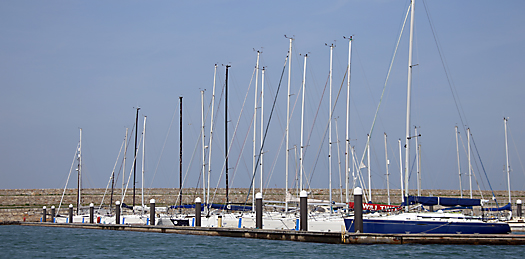
The Royal St George YC has introduced a direct ferry service from the clubhouse to its group of berths in the outer marina in Dun Laoghaire. Photo: David O'Brien
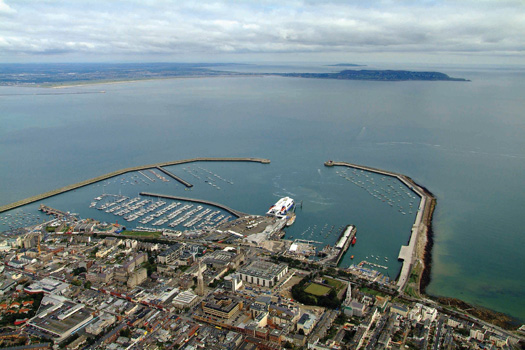
To overcome a lack of direct access to the Dun Laoghaire Marina, the Royal St George YC is running a ferry service from its clubhouse (to right of Stena Ferry, foreground) to the berths in the Outer Marina (upper left) Photo Kevin Dwyer/courtesy ICC.
Nevertheless, in all club administrations there are those who are of the opinion that, whatever the Honorary Treasurers may believe, there has to be a radical re-think of the primary subscription levels. In essence, they're suggesting that the book value of the club has to be written down such that subscriptions are halved. Personally, I haven't much of a notion of how to read a balance sheet, but the dogs in the street know that in the hospitality industry – which, in the broadest sense, is the area in which yacht and sailing clubs operate – values have been savagely slashed, and while charges may still seem high, at least the places are surviving as going concerns.
With continuing reduction in expenses across the board, one area in which there seems to be much work afoot is in the Irish Sailing Association, which in latter days had begun to seem like some hidden corner of the civil service, existing more for the benefit of staff than for the provision of services for sailors. It's amazing to learn that the ISA has sixteen fulltime staff, and a basic annual wages bill of something like €600,000. When you add in the expected benefits, it musty come in total to a very tidy yearly sum.
What on earth do they all do? While you'll invariably find the ISA logo in prominence at some top events, it has to be said that you're entirely unaware of the organisation's existence in any form at more everyday happenings, and it doesn't seem to be because they believe in doing good work by stealth. But with special study groups resulting from the major changes introduced in the ISA setup at the AGM in March, we can only hope that in time the Association will reflect the cost-cutting which has had to be introduced in the clubs, which provide the main part of the ISA's income.
While the administrative structures are rightfully being pared back in many areas of our sport, the coastal infrastructure, on which all forms of seagoing ultimately depend, continues to need maintenance and development. In this area, one very promising green shoot is the news that there are signs of movement in Dunmore East. A dredging programme is getting under way, and just this Tuesday, Minister for Marine Simon Coveney TD convened a meeting in the port to inaugurate a community approach to harbour development which, it is hoped, will help to invigorate the many places around Waterford Estuary, for which Dunmore East has the potential to be the true gateway harbour.

Dunmore East – can it fulfil its potential as the gateway leisure port for the Waterford Estuary? Photo Kevin Dwyer, courtesy ICC
In a more extreme marine environment, it has been confirmed that €6 million will be spent on improving the pier at Doolin in northwest Clare, the nearest mainland quay to the Aran Islands, which also caters for the tour boats cruising along the Cliffs of Moher. While the locals seem well pleased, I wouldn't get too excited about it. This is one very rugged part of the coast, and when you remember that it took €31 million to extend the pier at Kilronan in Inismor, the main Aran island, and another €14 million to build the little harbour at the north end of Inis Meain, the middle Aran island, then we can only hope that €6 million is going to achieve something more than a few boulders being shifted about in the roaring ocean at Doolin.

The pier at Doolin is decidedly minimalist, but it provides the shortest sea passage to the Aran Islands. Photo: W M Nixon
But then, in the west all things are possible, and along the ocean seaboard we're told that four thousand signs are being erected to guide people along the Wild Atlantic Way, the new tourism initiative using many smaller coastal roads. Quite so. Frankly, with signage at this level, it will be the Tame Atlantic Way by the time half of them are in place. I have to admit to being a complete curmudgeon in this. In many years of transitting Ireland's west coast by sea and land, one of our favourite areas while driving along the west coast has long been the coast south of Kilkee down to Loop Head, where the cliffs comfortably rival anything the vulgar Cliffs of Moher have to offer, and it is magnificently uncrowded. But not any more, if the Wild Atlantic Way movement has its way.
While I appreciate that visitor numbers have to be kept up and increased whenever and however, it has to be done in a way which appreciates that's what brings people to Ireland (rather than just to Dublin, which is a special case) is an unspoilt landscape. So, four thousand signs just for the one Atlantic Way? Ogden Nash had something to say about this:
"I think that I shall never see,
A billboard lovely as a tree.
But then, until the billboards fall,
I'll never see a tree at all".
Be that as it may, the final sign that suggests things are on the move again is a notice I spotted recently posted at a nearby club, though language pedants might wonder how a notice which manages to mangle so utterly the plural of "dinghy", even to adding a completely superfluous greengrocer's apostrophe, could be seen as encouraging in any way whatsoever.
Well, once you've overcome your opinions about the errors, the underlying message must be good news. More youngsters are evidently coming to sailing this year. And as for the spelling mistake, even that's an improvement. A year ago, the same notice board opened by referring to something called "a dingy", but this time round we have to get to the second line before finding that. And it all comes right for dinghies in the end.
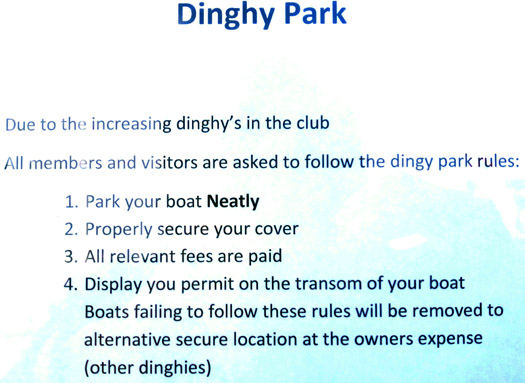
Sign of the times? Whatever about the spelling, this current notice at an Irish sailing club has an underlying message of good news. Photo: W M Nixon
Sports Council Calls for Submissions from Adventure Activity Providers on Safety & Standards
#sailingclubs – Feedback is required by Government 'on the safe and sustainable commercial provision of higher risk adventure activities' including sailing. In an initiative that will be of interest to Irish sailing clubs, sailing centres and instructors, the Irish Sports Council is inviting adventure activities providers to give their feedback on safety and standards in the adventure activities sector, and the development of a register of adventure activity providers.
According to the Sports Council the consultation process provides an opportunity for the adventure activities sector to consider and comment on the means by which current good practice in the sector might be consistently achieved, to support the safe and sustainable commercial provision of higher risk adventure activities.
John Treacy CEO, Irish Sports Council "I invite providers of adventure activities to attend one of the consultation meetings to discuss safeguarding, strengthening and promoting good safety practice within the adventure sector, or to make a written submission to the Council. This information will greatly assist the Council in developing a sensible and proportionate framework to address safety and standards. "
The consultation process includes a series of six meetings with adventure activity providers, as well as the opportunity for written submissions. They will be of interest primarily to commercial adventure activity providers but also to adventure activity instructors. The meetings will take place in Dublin, Galway, Sligo, Monaghan, Macroom and Carlow and will provide an opportunity for collaboration and feedback on shaping future safety standards within the sector.
Michael Ring T.D., Minister of State for Sport and Tourism "Last year, I asked the Irish Sports Council to examine the issues associated with safety and standards in the adventure activities sector, and the development of a register of adventure activity providers. Stakeholder consultation is an integral part of the process which will enable the Council to consider a wide range of views and take account of them in whatever proposals emerge"
The Irish Sports council also welcome written submissions about how current good practice in the safe commercial provision of higher risk adventure activities might be supported through legislation. Submissions can be sent up until 9th May to: Email: [email protected]
Post: Adventure Consultation, Irish Sports Council, Top Floor, Block A, Westend Office Park, Blanchardstown, Dublin 15




























